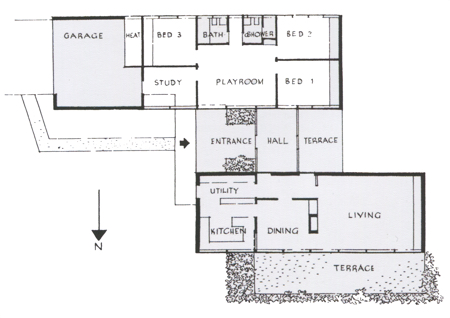8 Monaro Crescent, Red Hill (1952-53)
The Fenner House, at 8 Monaro Crescent, Red Hill, is located within the Red Hill heritage precinct. It was designed by Robin Boyd in 1952–53 for Professor and Mrs Frank Fenner, and built by Karl Schreiner in 1953-54. Professor Frank Fenner AC, CMG, MBE, FAA (21 December 1914 – 22 November 2010) was one of Australia’s leading virologists, noted for his work on myxomatosis and smallpox, and has won three of the world’s most prestigious awards: the Albert Einstein World Award for Science (August 2000), the Japan Prize for preventative medicine and the Copley Medal of the Royal Society (London).
The house is one of Canberra’s best examples of the post-war Melbourne regional style with its long unbroken roofline, widely projecting eaves and large areas of timber framed glazing. It makes an interesting comparison with the nearby Manning Clark House, also designed by Boyd and which also has a glass walled entrance gallery joining two wings of the house.
Other houses in Canberra designed by Boyd include the abovementioned Clark House (1952), the Roche house in Bedford Street, Deakin (1954), the W G Verge house at 204 Monaro Crescent, Red Hill (1963) and 12 Marawa Place, Aranda (1968–69).
Significance
The Fenner House at 8 Monaro Crescent, Red Hill, is listed on the ACT Chapter of the Australian Institute of Architects Register of Significant Twentieth Century Architecture. It is regarded by the AIA as being a very good example of the post-war Melbourne regional style with its large areas of glazing and vertical boarding, long unbroken roofline, metal roof and raked ceilings.

The original floorplan
The Fenner House represents a simple, bold, well planned and designed house that appropriately integrates the building with the corner block, set in a garden designed by important Canberra landscape architect Professor Lindsay Pryor. The design of the house was unique and advanced in Canberra at the time and is a significant work of Robin Boyd, a prominent Australian architect.
The Fenner House reflects the close Melbourne ties of many early academics at the Australian National University. The house was the first winner of the Meritorious Architecture Award of the Canberra Area Committee of the AIA in 1956.
Description
The house is set well back diagonally on a large corner block that slopes several metres from rear to front. The building consists of two parallel, off-set wings facing north-north-east which represent two living zones: the bedrooms, bathrooms and study in the rear wing and the eating and entertainment areas in the front wing. The two wings are linked by an enclosed, glass walled gallery.
The construction is double brick, with large areas of glazing in full height narrow timber frames. The brickwork is bagged and painted—grey on the north-south walls and white on the east-west walls, both original colours. The area underneath the glazing is painted in the original ‘celadon’ green colour. The roof is a long, unbroken, low pitch gable with internally raked ceilings.
In 1982 a large extension was added to the western end of the rear wing with a separate entrance off Torres Street. The extension was designed by Canberra designer Bill Douglas with the intention of being as close as possible in external appearance to the original part of the house. The roofline remains unbroken and the detailing of the eaves and glazing is identical to the original. At the rear, the extended portion of the building is approximately 1 metre deeper than the original rear wing.
Source
- Australian Institute of Architects RSTCA Citation No. R26
- Conversations with the owner, Professor Frank Fenner



